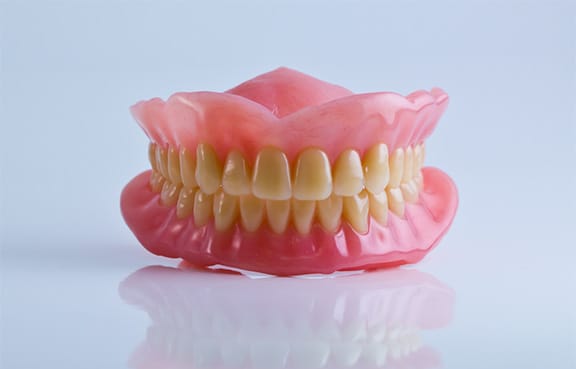Dentures

Denture Instructions
Occasionally, it is difficult to adapt to full or partial dentures. At first they may feel loose, bulky and awkward while speaking. For a quicker adjustment period, follow these instructions:
- At first, wear your dentures all the time.
- Do not use adhesive unless Dr. Barr advises you to do so.
- You should remove your dentures when you go to sleep.
- After removing dentures, clean with a toothbrush and place in a bowl of water. They can be soaked in a commercial denture cleanser, but brushing them is essential.
- Any signs of "sore spots," discomfort, or looseness that is causing you difficulty should be brought to our attention.
Never adjust the dentures yourself. Every person and every mouth is different; therefore, adjustment periods will vary.
Please remember that it will take time for you to become completely comfortable with your new teeth.
Implant Supported Dentures
This implant technique, is the optimal solution for those who have lost or are about to lose all of their upper and/or lower teeth. It's a procedure that comes closest to having a new set of permanent teeth.
Full Arch Dentures
A full arch denture is a removable tooth replacement option for those who need all their teeth replaced. They can be crafted to provide the characteristics (tooth shape and color) the patient desires. Advances have been made in the materials used for dentures and in the way they are designed. If you already have dentures (partial or full arch) you may be experiencing a loose fit or denture slipping. This can lead to gum sores, can affect your chewing and your speech and decrease your confidence when speaking and/or laughing with others. We can help restore your dentures to the correct fit.
Immediate Dentures
This type of denture is made to be placed in the mouth immediately after you have all your natural teeth extracted. This allows you to leave the office without the embarrassment of having no teeth while the gums heal from the extraction. The denture is made to conform to your mouth at the moment impressions were taken. Your gums will change drastically over the next few months and it is possible that the dentures will rub against the gums causing some soreness until the denture is adjusted. Most patients will require a realignment of their denture within the first few months due to the gums shrinking from the extraction of teeth. Another benefit of immediate dentures is the fact that the dentures act as a bandage to the extraction sites which covers the tooth sockets and prevents them from becoming irritated. Just remember, never remove the denture yourself, even for a brief moment unless your dentist has instructed you to. The gums have a tendency to swell when uncovered at first; and if you are without your dentures for a little while, they may never go back in.
Partial Dentures
Removable partial dentures are composed of a metal framework with plastic teeth and gum areas. The framework includes metal clasps or other attachments, which hold the denture in place. Partial dentures are removed easily for cleaning.
Clasps are C-shaped, I-shaped, and Y-shaped parts of the denture framework that fit around neighboring natural teeth. These teeth may require shaping to help hold the clasps and keep the denture securely in place.
Snap-In Dentures
Implants allow you to wear full dentures and partial dentures without fear that they will slip or fall out. A "snap-in" denture is an implant supported, removable denture. The snap-in feature is available for upper or lower dentures. Having implant supported dentures allows for the base of the denture to be made much smaller and more comfortable. Implant supported dentures enhance chewing and speaking. Never again will you have to worry about your teeth falling out when you eat, laugh or speak. You will regain chewing function and enjoy some forgotten foods.
Temporary Partials
Temporary or interim appliances serve many useful purposes and are often an integral part of a prosthetic treatment plan. These appliances can be designed to be either fixed or removable. This simple appliance is excellent for temporary replacement of front teeth while the patient is waiting for a permanent bridge, a partial, or implants. The appliance simply snaps into place.
Denture Resorption
Within 6 months of starting to wear a denture, you will have already lost about 40% of your jawbone structure.
If you have worn a denture for a few years, you already know about bone loss. The reason your denture doesn't fit like a year ago, is that you don't have the same jawbone structure to support it.
If you wear a partial denture, beware that you will have the same problem with bone loss.
Once the jaw bone structure is lost your options become limited. A dental implant is the logical choice to help stop bone loss, however, once the jaw bone structure is lost, your options become limited.